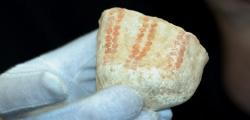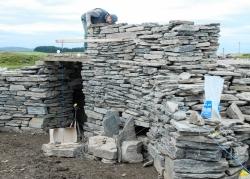09 NOVEMBRE
INDI-UNI : ANTHROPOLOGY - ARCHAEOLOGY
INSCRIPTION 2011 – 2012 COURS A DISTANCE
REGISTRATION 2011 – 2012 ONLINE COURSES
SUISSE –  Nyon - Découverte il y a 15 ans au centre-ville de Nyon, l’arène romaine dort sous des bâches, faute d’argent. Les vestiges de l’amphithéâtre romain de Nyon dorment depuis quinze ans sous des bâches, faute d’argent et de moyens de les mettre en valeur. En 1996, cette découverte avait pourtant soulevé un enthousiasme général, aboutissant à un grand concours d’architecture qui promettait de transformer cette arène en parc et lieu de spectacle et d’activités muséologiques.
Nyon - Découverte il y a 15 ans au centre-ville de Nyon, l’arène romaine dort sous des bâches, faute d’argent. Les vestiges de l’amphithéâtre romain de Nyon dorment depuis quinze ans sous des bâches, faute d’argent et de moyens de les mettre en valeur. En 1996, cette découverte avait pourtant soulevé un enthousiasme général, aboutissant à un grand concours d’architecture qui promettait de transformer cette arène en parc et lieu de spectacle et d’activités muséologiques.
http://www.24heures.ch/vaud-regions/-cote/amphitheatre-nyon-vestige-encombrant-2011-11-08
FRANCE – Dieppe - L'Institut national de recherches archéologiques préventives (Inrap) soupçonnait la présence d'un habitat gallo-romain sur le site du futur éco-quartier du Val d'Arquet. Il y a bien une ferme qui a conservé tous ses mystères.
http://www.paris-normandie.fr/article/autres-actus/une-ferme-gallo-romaine
FRANCE –  Castres - Jusqu'au 17 novembre, des archéologues effectuent des sondages sur l'Albinque avant que ne commençent les travaux d'aménagement de la place. Ils espèrent retrouver trace des anciennes fortifications de la ville. Hier, à proximité du foirail, les chercheurs ont mis à jour un bout de mur epais qui « pourrait » appartenir aux anciennes fortifications de la ville, un rempart à la Vauban du XVIIe : « On ne peut rien affirmer pour l'instant. Nous avons prélevé des élements qui ensuite nous permettrons de dater cette construction. » précise bien l'archéologue. Une boucle en métal et des débris de céramique ont notamment été extraits hier de la longue saignée de 20 mètres de long pratiquée sur près de 2 mètres de profondeur. Aujourd'hui, au beau milieu du foirail qu'une tranchée sera réalisée pour faire de même. Ce sont ainsi dix emplacements de l'Albinque qui seront fouillés durant cette campagne destinée à fournir une photographie du sous-sol de la place avant travaux.
Castres - Jusqu'au 17 novembre, des archéologues effectuent des sondages sur l'Albinque avant que ne commençent les travaux d'aménagement de la place. Ils espèrent retrouver trace des anciennes fortifications de la ville. Hier, à proximité du foirail, les chercheurs ont mis à jour un bout de mur epais qui « pourrait » appartenir aux anciennes fortifications de la ville, un rempart à la Vauban du XVIIe : « On ne peut rien affirmer pour l'instant. Nous avons prélevé des élements qui ensuite nous permettrons de dater cette construction. » précise bien l'archéologue. Une boucle en métal et des débris de céramique ont notamment été extraits hier de la longue saignée de 20 mètres de long pratiquée sur près de 2 mètres de profondeur. Aujourd'hui, au beau milieu du foirail qu'une tranchée sera réalisée pour faire de même. Ce sont ainsi dix emplacements de l'Albinque qui seront fouillés durant cette campagne destinée à fournir une photographie du sous-sol de la place avant travaux.
http://www.ladepeche.fr/article/2011/11/09/1211787-castres-a-la-recherche-des-remparts-de-l-albinque.html
ALLEMAGNE – 
 Hohle Fels - Archaeologists have found cave paintings thought to be Central Europe's oldest such artwork in Baden-Württemberg’s Swabian Alps. They found four painted stones from the cave Hohle Fels near Schelklingen, although the meaning of the red-brown spots is still a mystery. The stone paintings, thought to be 15,000 years old, are being displayed at a special exhibition at the University of Tübingen’s museum. The spots don’t seem particularly artistic at first glance. But they are important because they represent the first time such old paintings have been found in Central Europe, although similar work has been seen in France and Spain.The stones at Hohle Fels appear to have been painted with a mixture of red chalk and lime, with water from the cave, said excavation technician Maria Malina. “These spots are anything but accidental,” said archaeologist Nicholas Conard who assisted on the find. “It is quite clear that they have relevant content.” What it all really means remains unclear. There is speculation the spots could refer to shamanism or be a menstrual calendar of sorts. Hohle Fels has been a magnet for archaeologists in recent years after researchers working there found a Venus figure and flutes thought to be 40,000 years old.
Hohle Fels - Archaeologists have found cave paintings thought to be Central Europe's oldest such artwork in Baden-Württemberg’s Swabian Alps. They found four painted stones from the cave Hohle Fels near Schelklingen, although the meaning of the red-brown spots is still a mystery. The stone paintings, thought to be 15,000 years old, are being displayed at a special exhibition at the University of Tübingen’s museum. The spots don’t seem particularly artistic at first glance. But they are important because they represent the first time such old paintings have been found in Central Europe, although similar work has been seen in France and Spain.The stones at Hohle Fels appear to have been painted with a mixture of red chalk and lime, with water from the cave, said excavation technician Maria Malina. “These spots are anything but accidental,” said archaeologist Nicholas Conard who assisted on the find. “It is quite clear that they have relevant content.” What it all really means remains unclear. There is speculation the spots could refer to shamanism or be a menstrual calendar of sorts. Hohle Fels has been a magnet for archaeologists in recent years after researchers working there found a Venus figure and flutes thought to be 40,000 years old.
http://www.thelocal.de/sci-tech/20111109-38751.html
ROYAUME UNI –  Spittal - An architecture project held at Spittal has given a greater insight into early stone brochs in Caithness. During excavations at Thrumster Broch in July, archeologists discovered evidence that the original entrance of the broch had been blocked, perhaps to help combat the effects of subsidence. It was believed the broch had been partially dismantled to ground level and rebuilt to incorporate a new entrance in a more stable area. But the findings at Spittal suggest it may have been possible to remove stones from the bottom and build a new doorway without the whole structure tumbling down. The project will resume next spring. In the meantime experts will be looking at alterations in larger surviving brochs to see if they could credibly be identified as repairs, maintenance or modification of the original broch structures.
Spittal - An architecture project held at Spittal has given a greater insight into early stone brochs in Caithness. During excavations at Thrumster Broch in July, archeologists discovered evidence that the original entrance of the broch had been blocked, perhaps to help combat the effects of subsidence. It was believed the broch had been partially dismantled to ground level and rebuilt to incorporate a new entrance in a more stable area. But the findings at Spittal suggest it may have been possible to remove stones from the bottom and build a new doorway without the whole structure tumbling down. The project will resume next spring. In the meantime experts will be looking at alterations in larger surviving brochs to see if they could credibly be identified as repairs, maintenance or modification of the original broch structures.
http://www.johnogroat-journal.co.uk/News/Your-Community/Spittal-build-project-brings-new-insight-into-brochs-07112011.htm
TURQUIE –  Kumluca - The Antalya Museum in southern Turkey is hoping to get back the rest of Sion Treasure from the Dumbarton Oaks Institute in Washington, D.C. The Sion Treasure was found by a villager by accident in Kumluca town in Antalya province in 1963. The treasure, which was later smuggled abroad, was named from an inscription on an oblong “polycandelon” (multiple-lamp holder) mentioning “Holy Sion,” possibly the church or the monastery for which the objects were intended. The monastery of Holy Sion was near present-day Kumluca. The museum director said that the Antalya Museum was located on an area of 30,000 square meters, and 60,000 artifacts were registered in the museum.
Kumluca - The Antalya Museum in southern Turkey is hoping to get back the rest of Sion Treasure from the Dumbarton Oaks Institute in Washington, D.C. The Sion Treasure was found by a villager by accident in Kumluca town in Antalya province in 1963. The treasure, which was later smuggled abroad, was named from an inscription on an oblong “polycandelon” (multiple-lamp holder) mentioning “Holy Sion,” possibly the church or the monastery for which the objects were intended. The monastery of Holy Sion was near present-day Kumluca. The museum director said that the Antalya Museum was located on an area of 30,000 square meters, and 60,000 artifacts were registered in the museum.
http://www.hurriyetdailynews.com/n.php?n=turkey-hopes-to-get-back-sion-treasure-2011-11-09
IRLANDE – Newtown - The astonishing story of a Norman town lost for centuries is being brought back to life. Cutting edge LIDAR technology, deployed by armed forces to detect underground bunkers, has uncovered the streets, towns and dwellings of an early Norman settlement known as Newtown just outside Thomastown. Within 15 miles of Kilkenny, the medieval settlement has been the focus of a recent archaeological dig backed up by the latest technology to tell the story of what has been described as ’Kilkenny’s Pompeii.’ Newtown, which contains the site of St Nicholas Church, has long been known as a site of historical importance. Apart from local legend, the site next to Belmore House has been earmarked as one of historical importance dating back over 100 years when it first appeared on an ordnance survey map. Recent discoveries with the help of technology, and also the unearthing of a tombstone for a 13th century monk called Thomas Poer, has shined a spotlight on medieval life at the settlement. The story of Newtown dates back to the 1200’s when its size was comparable to half of the city of Kilkenny. But within two centuries, the town simply vanished off the map apart from St Nicholas Church and graveyard, which remained as a parish church for the area. The closure of nearby Jerpoint Abbey in the mid 14th Century by King Henry VIII sealed the fate of Newtown.
http://www.kilkennypeople.ie/news/local/startling_discovery_of_lost_norman_town_1_3229885